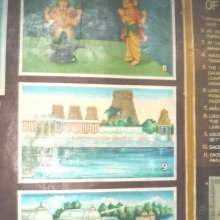Dissolution, Dissolved, Dissolve, Dissolving: 2 definitions
Introduction:
Dissolution means something in Hinduism, Sanskrit, Jainism, Prakrit. If you want to know the exact meaning, history, etymology or English translation of this term then check out the descriptions on this page. Add your comment or reference to a book if you want to contribute to this summary article.
Images (photo gallery)
In Hinduism
Yoga (school of philosophy)
Source: ORA: Amanaska (king of all yogas): A Critical Edition and Annotated Translation by Jason Birch1) (Being) Dissolved can denoted by the Sanskrit terms Līna, according to the Amanaska Yoga treatise dealing with meditation, absorption, yogic powers and liberation.—Accordingly, as Īśvara says to Vāmadeva: “[...] [Now], I shall define the nature of that highest, mind-free absorption which arises for those devoted to constant practice. [...] Just as ghee which has dissolved (līna) into [another batch of] ghee, is not separate [in any way] from [that] ghee, so the Yogin, who has dissolved into the highest reality, is not aware of separateness. [...]”.
2) The Dissolution (e.g., of Viṣṇu and Śiva) is denoted by the Sanskrit term Pralaya according to the Haṭhatattvakaumudī by Sundaradeva: a large compendium on Yoga in roughly 2000 Sanskrit verses quoting from Yoga texts, Upaniṣads, Epics, Purāṇas, Dharmaśāstras etc.—Accordingly, while discussing that Yogins enjoy an eternal bliss that is beyond the transcience of religious merit: “[...] There is no imperishable happiness without yoga. And so, it is said in the Amanaska: ‘Even in the dissolutions (pralaya) of Viṣṇu and Śiva, Yogins enjoy supreme bliss, like the great-souled Bhuśuṇḍa and others’.”.

Yoga is originally considered a branch of Hindu philosophy (astika), but both ancient and modern Yoga combine the physical, mental and spiritual. Yoga teaches various physical techniques also known as āsanas (postures), used for various purposes (eg., meditation, contemplation, relaxation).
In Jainism
General definition (in Jainism)
Source: ORA: Amanaska (king of all yogas): (Jainism)The Dissolution (of the body) is denoted by the Sanskrit term Pralīna, according to verse 12.42 of Hemacandra’s Yogaśāstra.—Accordingly, “At the time of the arising of the no-mind state, the Yogin experiences the body, which is as though it does not exist, as though [it were] separated, burned, flying up and dissolved (pralīna)”.

Jainism is an Indian religion of Dharma whose doctrine revolves around harmlessness (ahimsa) towards every living being. The two major branches (Digambara and Svetambara) of Jainism stimulate self-control (or, shramana, ‘self-reliance’) and spiritual development through a path of peace for the soul to progess to the ultimate goal.
See also (Relevant definitions)
Starts with: Dissolution Contemplation.
Full-text (+1418): Vilaya, Vishleshana, Vilayana, Pralaya, Khandapralaya, Pralina, Vilina, Prakritapralaya, Dravaka, Lina, Vili, Dravanem, Phutaphuta, Shankhadrava, Layasthana, Bhavavyaya, Apiti, Pancatva, Pajharanem, Visarman.
Relevant text
Search found 287 books and stories containing Dissolution, Dissolved, Dissolve, Dissolving; (plurals include: Dissolutions, Dissolveds, Dissolves, Dissolvings). You can also click to the full overview containing English textual excerpts. Below are direct links for the most relevant articles:
The Devi Bhagavata Purana (by Swami Vijñanananda)
Chapter 38 - On the glories of the Devī and on the nature of Bhakti < [Book 9]
Chapter 21 - On the meeting of Mahādeva and Śaṅkhacūḍa for an encounter in conflict < [Book 9]
Chapter 3 - On the origin of Brahmā, Viṣṇu, Maheśa and others < [Book 9]
Shat-cakra-nirupana (the six bodily centres) (by Arthur Avalon)
The Great Chariot (by Longchenpa)
Part 2c.7 - How the noble ones are perfected by full attainment < [B. The gradation of powers of those who meditate into high, middle, and low]
Part 1b.1f - How consciousness dissolves < [B. The extensive explanation of the nature of karma]
C. How these arise from space and dissolve into space, the final summary < [Chapter XIII - The Fruition, the Great Self-existence]
The Tattvasangraha [with commentary] (by Ganganatha Jha)
Verse 2198-1299 < [Chapter 24a - The case for the reliability of the Veda (the Revealed Word)]
Verse 101-102 < [Chapter 3 - Dealing with the doctrine of both God and Primordial Matter (prakṛti)]
Verse 162-163 < [Chapter 6 - Doctrine of the Spirit (puruṣa) Personality as cause of the world]
The Linga Purana (by J. L. Shastri)
Introduction (1): The Liṅga-purāṇa
Chapter 32 - Hymn to Lord Śiva < [Section 1 - Uttarabhāga]
Chapter 19 - Enlightenment of Viṣṇu (viṣṇuprabodha) < [Section 1 - Uttarabhāga]
The Great Chronicle of Buddhas (by Ven. Mingun Sayadaw)
Part 3 - Definition of Kappa or Aeon < [Chapter 1-3 - Anudīpanī on words and phrases]
Part 1 - Five Kolāhalas < [Chapter 1 - The Story of Sataketu Deva, The Future Buddha]
Part 11 - Dependent Origination: Paṭiccasamuppāda < [Chapter 42 - The Dhamma Ratanā]
Related products
(+17 more products available)








